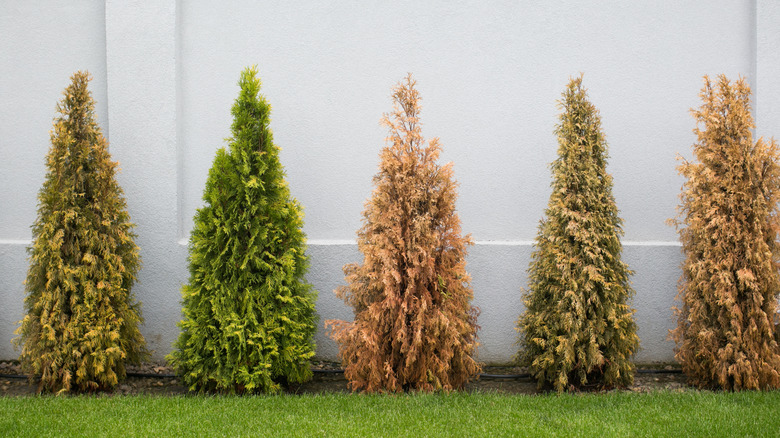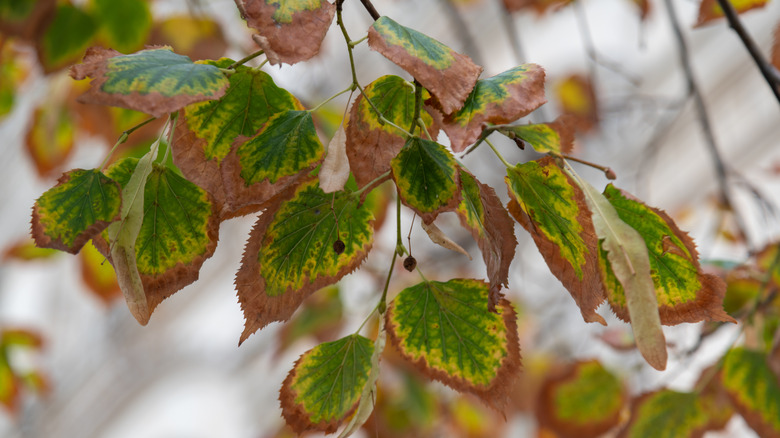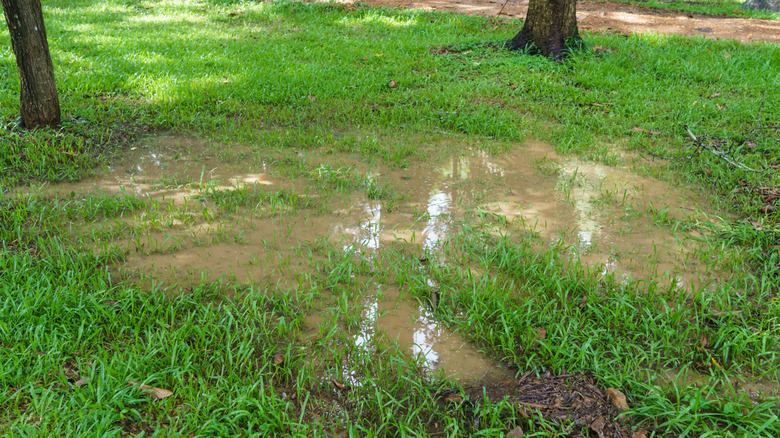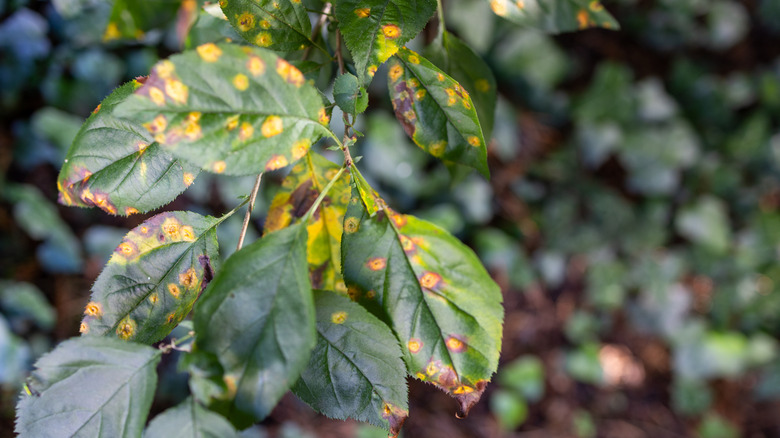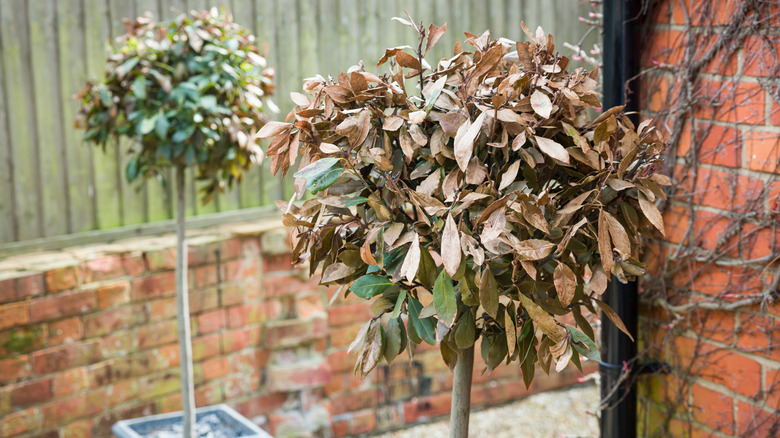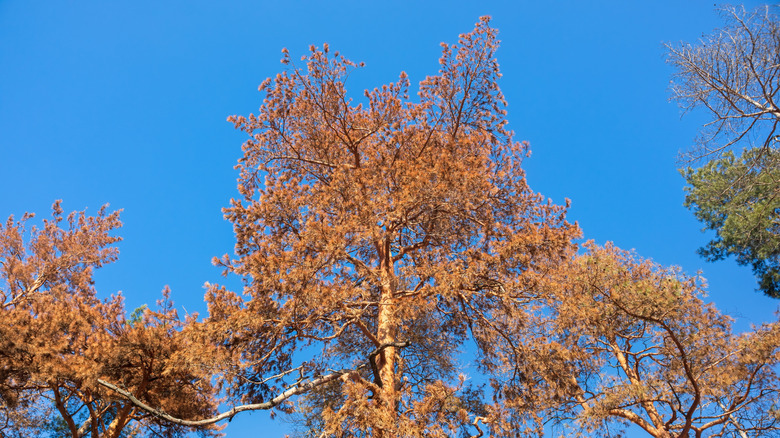The Most Common Reasons Your Tree Leaves Are Turning Brown And Dying
Spotting a few brown or dying leaves on your tree can be distressing. While it's probably not a reason to panic, it is a sign that you should take a closer look at your tree's health. A lot of different problems can cause a tree's leaves to turn brown, and distinguishing between those causes comes down to looking for context clues, like the recent weather or your care routine over the past few weeks.
From a lack of water to too much water to transplant shock, disease, and death, there are a wide variety of potential causes that all have different solutions. Fortunately, unless you have a dead tree on your hands, most of these issues can be corrected with a little extra care and maintenance on your part. In some cases, the solution might be as simple as watering more deeply or adding some mulch. In other cases, you might need to do a little more work to eliminate the stressors that are harming your tree.
The key is to catch the issue early and pay attention while you're treating it to make sure you've correctly diagnosed the root problem. If the tree doesn't start to show signs of recovery, you might be treating the wrong issue. In that case, you'll need to take a look at the symptoms again and try to figure out what's really going on. To help you narrow down the possibilities, here are some of the most common reasons to look for and what to do if you find brown leaves on a tree.
Leaf scorch or drought stress
In summer, browning leaves might be a sign of leaf scorch. A healthy leaf relies on a process called transpiration to cool itself down. Water is pushed through the pores to lower the surrounding air temperature — similar to the way you might break a sweat. But as the sun's rays cause more intense heat to hit the top of the canopy, leaves become prone to scorching, especially without enough moisture to use for transpiration. To help your tree, first make sure you're watering it when you should be.
It's important to consider where the scorch is happening. If the scorched leaves are concentrated at the top of the tree, this might just be an unusually hot or dry spell. Again, giving it extra water during the hottest summer days can help. If the issue affects the entire tree, it might be suffering from long-term drought stress and struggling to cool itself as well as it normally would. One way to distinguish drought stress from other problems is by looking at all the symptoms present. In addition to brown leaves, are there also yellowing or lighter green leaves? Are the leaves wilting? Has your tree suddenly started to produce more seeds than usual? All of these can be signs that drought is the problem.
If you've been following the right watering guidelines for your tree, you might not be watering deeply enough. Getting the measurements for watering deeply right can be tricky. Namely, it's important to saturate the entire root zone — and a tree's roots typically spread out about two to four times the size of its canopy. If you've only been watering near the base of the trunk, you might be leaving the bulk of its root system parched.
You're overwatering the tree
Don't leap to watering a tree with brown leaves. Frustratingly, the signs of drought stress can look very similar to the symptoms of a tree that's been watered too much. When the soil is oversaturated, roots can rot, becoming incapable of taking up water. Once they can't take up water, the leaves will start to dry out just as they would if your tree were suffering from a lack of water.
If you mistake those symptoms for drought and add more water, you could end up making the problem worse or even killing the tree. On the other hand, if you avoid watering for fear of root rot and it turns out your tree is actually lacking water, you could cause your tree additional stress and damage. To avoid making either of those mistakes, you need to check the soil. Dig down a few inches with your hand to feel how dry or moist the soil is. If it's moist or soggy, skip watering and figure out why there's so much moisture.
For example, is the tree near a downspout or in a low area that tends to flood after rain? If so, relocate it if it's young enough to transplant. If you want a tree in that specific spot, opt for one that likes wet feet. Another possibility is compaction. You can improve compacted soil by tilling compost into it. Then, cover with an organic mulch like wood chips or leaves. Top off that mulch each year as it decomposes and the soil will get healthier over time. Until then, continue to check soil moisture before watering to avoid overwatering.
The tree is diseased
A variety of diseases can cause tree leaves to turn brown. If disease is the culprit, it'll usually first appear as brown, tan, or yellow spots on some leaves, almost like a rash. Other signs and symptoms largely depend on the tree species and the type of diseases it's prone to. If the affected leaves are mostly on the lower branches, or if they first appear when humidity is highest in your climate, it might be a fungal disease taking advantage of the warm, damp conditions. If the spots are scattered randomly across the foliage, it might be a bacterial or fungal infection that was transmitted by wind or rain.
To better figure out if you're dealing with a tree disease and the best steps to treat it, start by researching the most common diseases faced by the tree species in your yard. In the meantime, curb the spread of fungal or bacterial diseases by raking fallen leaves away from your trees and throwing them away. If the canopy is dense and it's humid, you might want to prune smaller branches here and there to improve airflow. But don't remove too many branches in late summer, because this can stress the tree at a time when it's already vulnerable to heat and potentially weakened by disease. Instead, wait until it goes dormant to do heavier pruning to prevent the disease from coming back next year.
It's experiencing transplant shock
If the tree with browning leaves is one you recently planted in your yard, transplant shock is the likely culprit. Symptoms of transplant shock include brown foliage, premature leaf drop, and a noticeable decline in the amount of new growth. The stressed tree will also be more vulnerable to other problems like pests and disease. You can prevent transplant shock by opting for younger trees, planting them while they're dormant in the winter, and digging a hole that allows their roots to spread out. The hole should be at least twice as wide, and the same depth as the root ball.
If the tree is already in the ground, digging it up to fix mistakes you made when transplanting won't help. Fortunately, you may succeed in salvaging the stressed tree in your yard by taking good care of it for the first few years while it's getting established. Depending on the extent of the shock, which can roughly be measured by the percentage of leaves that have turned brown and died, it might recover by the next growing season, or it might take several years.
To help your tree overcome this shock, mulch its base with a 2- to 3-inch layer of wood chips or pine straw to keep soil temperature and moisture consistent. Then, water regularly for the rest of the growing season. Lastly, resist the temptation to apply fertilizer. A freshly transplanted tree needs to focus on root development, and fertilizer can stimulate new top growth that the roots aren't yet strong enough to support.
The tree is dead
If all the leaves on your tree have suddenly turned brown this year, but are still attached to the branches, that's a big indicator that the tree has finally succumbed to a problem it's been struggling with for a long time. Even if you've done nothing different and there was no obvious injury or issue to the tree in the past, one or more injuries could have happened over the course of the last few years that gradually weakened the tree.
In newly built neighborhoods, for example, the tree's roots might have been damaged during construction and the weakened root system couldn't keep up with the tree's water or nutrient needs. In areas where herbicide use is common — like the weed and feed products many homeowners regularly use on lawns — the repeated exposure may have gradually damaged the tree. Even regularly occurring droughts or storms, which may be normal in your region, can wear down a tree over time, especially one that's younger or not adapted to the climate.
If your tree is dead, there's no resurrecting it. But figuring out the possible factors that contributed to its death can help you prevent that from happening to its replacement or other trees on your property. For example, you might make an effort to water the trees more during droughts or limit the use of herbicides in your yard.
